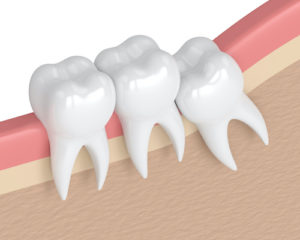Impacted teeth are a common reason for visiting the dentist outside of a patient’s routine care. Wisdom teeth are often the culprit when it comes to impacted teeth. The bicuspids and the cuspids (the premolars and canine teeth, respectively) are commonly affected by this issue. However, any tooth can become impacted, given the right circumstances. The experienced dentists and hygienists at Lovett Dental Heights can treat this and other general dental issues.
Impacted Teeth Explained
Impacted teeth become trapped between the person’s gum tissue and jawbone. This most often occurs when the tooth does not erupt from the gum as expected. It can also happen when the tooth is misaligned so that it cannot emerge from the gum.
Wisdom teeth, especially, are prone to becoming impacted. This is primarily because most people do not have enough space in their jawbones to allow the teeth to erupt freely.
These ‘third molars” tend to be the last teeth that emerge for most people. In addition to having all their other teeth taking up room within their mouths, many people have wisdom teeth wider and larger than their other molars.
Side Effects Caused by Impacted Teeth
Tooth impaction can cause huge issues for those people who are affected by it. In addition to the actual impacted tooth being affected, in many cases, the teeth nearby also experience problems.
A patient struggling with impacted wisdom teeth will likely feel pain when they open their mouth, and they might find it difficult to do so. The person might also find it painful to bite and chew. Other side effects could include an unpleasant odor or taste in their mouth.
Also, the impacted tooth’s gum tissue might become swollen and painful. This could make it more likely that the patient will get an infection of this now-vulnerable tissue.
If it is left untreated, a tooth impaction could cause the formation of tumors or cysts. These could lead to permanent damage as tissue and bone are destroyed.
Overcrowding of the patient’s teeth, gum disease, cavities, and other decay symptoms are possible side effects if the impacted tooth is not addressed promptly. Eventually, the bones and teeth that are situated nearby could also be absorbed.
How Are Impacted Teeth Found?
With routine dental appointments and oral care, a patient can often become aware of a tooth impaction before it causes pain, swelling, and other types of discomfort. As part of their regular dental visits, a patient typically has different types of X-rays that could alert the dentist to the presence of teeth that could become impacted.
For tooth impaction that is more advanced, the patient might be the one to schedule a visit with the dentist to address the swelling, redness, and pain that they are experiencing. After verifying that the patient has an impacted tooth, the dentist will recommend an appropriate course of treatment.
Treating an Impacted Tooth
For most patients, the best course of action is impacted teeth removal. Because an impacted tooth is not aligned correctly or unable to fully emerge from the gum, removing it allows the other teeth to have more space.
An impacted tooth can cause a great deal of pain and discomfort. However, Lovett Dental Heights is here to help. Our multidisciplinary dental practice provides the full scope of treatment options with a focus on helping our patients enjoy dazzling smiles and excellent oral health.
We provide the following specialties:
- Orthodontics
- Oral surgery
- Maxillofacial
- Pediatrics
- Periodontics
Contact the friendly and compassionate staff at Lovett Dental Heights today at 832-767-2210, or contact us online and learn how to help you with everything from routine care and oral surgery to impacted teeth and braces.
